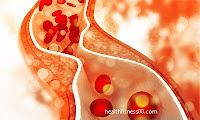Cholesterol and Risk Factors | HealthyFits
Cholesterol is an important oil-based substance that migrates into the body as a lipoprotein.
Blood is completely water-based so that LDL cholesterol does not mix with blood.
It happens in every physical unit. Cholesterol has important natural functions in nutritional digestion, hormone production and nutrient production. D. The body produces cholesterol, but people eat cholesterol in their diet. The wax appears and seems to be made of wood.
Cholesterol Types
There are two kinds:
low-density lipoprotein (LDL) or "bad" LDL cholesterol:
Cholesterol produced in this way is unhealthy or "bad" cholesterol.
High-density lipoprotein (HDL) or good cholesterol
HDL cholesterol is called "good" cholesterol.
The main function of cholesterol
There are four main functions of cholesterol.
1- Helps form the cell wall.
2-digestive bile acids in the intestine.
3- Let the body go on a diet.
4. Let the body produce safe hormones.
High cholesterol level
High cholesterol is a deadly factor leading to coronary heart disease and coronary heart disease.
The cholesterol accumulation, which is part of the process of arterial stenosis, causes atherosclerosis. It can lead to arteriosclerosis and affect blood flow.
Lowering cholesterol levels in the diet helps control LDL cholesterol. In particular, it makes sense to restrict the products in.
Cholesterol contains animal products, meat and cheese.
Saturated Fats: This is caused by eating certain types of meat, milk, chocolate, confectionery, fried and processed foods.
TASA TRANS: It occurs in some fried and processed foods.
Obesity can increase the amount of LDL in the blood. Genetic factors can cause a high cholesterol level. Hereditary familial hypercholesterolemia has a high LDL level.
Other diseases that can cause high cholesterol levels are:
- Syndrome of polycystic ovaries.
- Refractory thyroid
- Diabetes
- Kidney disease.
A drug that improves LDL. Lowering LDL cholesterol and HDL cholesterol like progesterone, anabolic steroids and corticosteroids.
Pregnancy rates and other conditions for increasing female hormone levels.
High Cholesterol Symptoms
People with high cholesterol levels usually have no symptoms or signs, but they can help you identify high cholesterol levels through regular activity and blood tests.
People who are not on the list at this time may not find that it is hypercholesterolemia.
High Cholesterol Found in :
- Eggplant and okra
- Vegetable oil (rapeseed, sunflower).
- Provide barley input
- Fatty fish (especially salmon, tuna and sardines).
- Fruits (mainly apples, grapes, strawberries, citrus fruits)
- Soya and soy-based foods.
Cholesterol-lowering Foods
- Hardened oil
- Pastries
- Red meat
- Large amounts of fat
- Marin
Health effects of cholesterol
In adults, the total LDL cholesterol level is below 200 mg / dl (mg / dl).
Prices range from 200 to 239 mg/dl, which is a higher limit.
With more than 240 mg/dl, the measured value is considered high.
LDL LDL cholesterol levels should be below 100 mg.
100-129 m.
130-159 mg / dl.
160-189 mg / dl.
Values above 190 mg/dl are very high.
The HDL area should be high. The maximum price for HDL is over 60 mg/dl.
Doses below 40 mg/dl are the main risk factors for heart disease.
Limited values? Reduced from 41 mg / dl to 59 mg / dl.
How To Lower High Cholesterol Levels
- If you want to lower the LDL cholesterol or keep it real, you can choose from 4 lifestyle options.
- stop smoking
- Achieve and maintain a healthy weight
- Eat healthily
- Regular exercise
- This behaviour reduces the risk of coronary heart disease and coronary heart disease.

Comments
Post a Comment